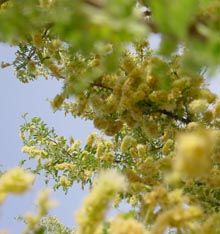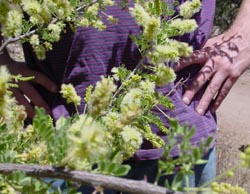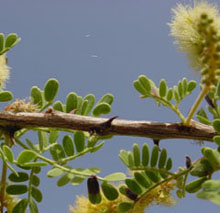Acacias
Main sources: Kearney, Thomas & Robert Peebles, et al., 1960, Arizona Flora, pp. 397-99, Berkeley: University of California Press; Petrides, George & Olivia Petrides, 1992, A Field Guide to Western Trees, pp. 119, pl. 20; Hodgson, Wendy, Food Plants of the Sonoran Desert, p. 163; Hultine, Kevin, "The Taxonomy of North and South American Mesquites", Aridus 13:2:May 2001.
Acacias include over a hundred species of trees and shrubs, many of which grow in extremely harsh desert environments. In our area they run in size and texture from small, almost non-woody herbaceous plants to woody shrubs and small trees. As legumes, they have two-valved seedpods, but otherwise they differ considerably in appearance.
The ancestors of Acacias as well as most other legumes must have arisen during the late Jurassic Era, after the breakup of the great global-continent Pangea some 165 MYA, in the ancient continent of Gondwanaland -- the supercontinent composed of ancestral continents of South America, Africa, India, Antarctica, and Australia -- because Acacias are native to Australia as well as these other (now widely separated) southern continents (but not to North America, which had separated from all of them with the breakup of Pangea). This indicator of great age distinguishes them from mesquite, whose origins are later, tracing only to South America.
Below, the essential feature of leguminous plants: simple, dry, bean-bearing pods, in this case slowly ripening Cat's Claw Acacia pods, photographed on a terrace above the floodplain of the San Pedro River July 6, 2007. Click on the image to enlarge it.

 Catclaw Acacia (Acacia greggii), also called "Devil's Claw", a common shrub or small tree along slopes or washes in our area, it ranges from the Pacific coast to the Gulf of Mexico and is known as "probably the most heartily disliked plant in [Arizona], the sharp, strong prickles tearing the clothes and lacerating the flesh" [Kearney & Peebles p. 398]. Its characteristic thorns may best be seen here in the banner photo at the top of the page. The leaves are 1 to 3" long, each having 1-3 pairs of major leaflets, and each of these having 3-7 pairs of minor leaflets (click on image below to enlarge). Leaves are deciduous only briefly (in contrast to mesquite and palo verde). Catclaw is very drought-resistant and may form thickets that are difficult to traverse. It is found in a wide variety of ecozones, from desert grasslands to the pinyon-juniper zone. Typically the bark is gray throughout the plant.
Catclaw Acacia (Acacia greggii), also called "Devil's Claw", a common shrub or small tree along slopes or washes in our area, it ranges from the Pacific coast to the Gulf of Mexico and is known as "probably the most heartily disliked plant in [Arizona], the sharp, strong prickles tearing the clothes and lacerating the flesh" [Kearney & Peebles p. 398]. Its characteristic thorns may best be seen here in the banner photo at the top of the page. The leaves are 1 to 3" long, each having 1-3 pairs of major leaflets, and each of these having 3-7 pairs of minor leaflets (click on image below to enlarge). Leaves are deciduous only briefly (in contrast to mesquite and palo verde). Catclaw is very drought-resistant and may form thickets that are difficult to traverse. It is found in a wide variety of ecozones, from desert grasslands to the pinyon-juniper zone. Typically the bark is gray throughout the plant.
Despite their thorny character, Catclaws are very beautiful when they blossom, as can be seen in the images below:
 ..
..
Going along a wash, you can distinguish catclaw blossoms from those of mesquite by their lighter yellow color, appearing almost whitish in contrast to the almost orange mesquites, and by their shorter length, 1-2 inches long, some almost ball-like in contrast to the long mesquite spikes (but compare Whitethorn Acacia, below). The blossoms are quite fragrant and are much visited by bees; they produce good quality honey.
Catclaw fruit pods are 2-3" long, flat but strongly twisted. The plants are browsed by cattle and are eaten by deer, peccaries, rabbits, and numerous birds and rodents. The pods were rarely consumed by Native Americans, though they ripen and fall at the onset of the summer rains and are thus available at times of great food shortage. Where people pounded the seeds into meal, they probably did so only in hard times, since Catclaw seeds and herbage both produce poisons and the seeds may produce some chemicals that interfere with protein digestion [Hodgson p.163].
Catclaw thickets provide refuges for various birds and small mammals. Catclaw wood is very hard and strong, though large trees are rare. In the photo below, an unusually large Catclaw log serves as a bench before an open campfire hearth:

Below: see how a rather small Catclaw Acacia shrub possesses a quite massive root system, part of which has been rather recently exposed in Lower Sierra Blanca Canyon Wash:

The O'odham used Catclaw for constructing their Saguaro fruit harvesting poles, twigs for various kinds of basketry, and women used dried blossoms for perfume.
Whitethorn Acacia (Acacia constricta), also a common plant of the Arizona Uplands portion of the Sonoran Desert, in scattered distribution but occurring most densely in washes. It is often found with Creosotebush and other shrubs. Its leaves are twice-compound with 3 to 6 pairs of leaflets per leaf, and its spines (left) long, straight, and white (occurring on new growth mainly), its flowers bright yellow fuzz-balls (below). Its reddish bark on young stems (also to left, and left below -- showing its open, barren structure during uplands drought) -- is also a useful identifier.

 ..
.. ..
..
Incidence of thorns is highly variable -- compare the center plant with the one to the right (click to enlarge).
Whitethorn is winter-deciduous, but renews its leaves only after adequate summer rains. It is eaten by a variety of birds and small mammals. Like Catclaw, it is long-lived and may develop into a small tree. Like Catclaw, it is an invader of desert grasslands.

For more images of Whitethorn acacia, see Whitethorn.
Return to Trees & Shrubs

